The chord of F Major is a hugely popular chord on the guitar, but one that causes all sorts of problems for beginners. Some guitarists try to play the big full barre which only leads to lots of buzzing notes and some only play the super mini version, which if not played correctly, can sound weedy and thin.
As you can see from (my rather dodgy) illustration, the F Major chord can be one hell of a frustrating chord that makes people want to curse to the high heavens or make grown men and women weep with anguish and smash their guitars up in frustration.
Well, fear not fellow guitarist. In this post, I’ll show you how to play the chord of F Major in a progressive manner starting with the hard versions and then breaking these down into simpler forms.
I’ll also show you how to play an unusual inversion of the chord too which can really add class to your playing in certain situations.
A while back I showed you multiple ways to play the tricky B minor chord on guitar and more recently the B flat chord on guitar which is also a challenging chord to play. The chord of F is a more common chord as it is in the key of C Major—one of the CAGED keys on the guitar.
The F chord is also used in other keys too and quite often when a musician is playing in the key of G Major they will substitute out the F# diminished chord to bring in an F Major chord. This makes the F really important.
Here are a bunch of songs that use the F chord (most don’t use a capo but a few do).
- John Lennon – Imagine
- Oasis – Don’t look back in anger
- Coldplay – The Scientist
- David Bowie – Space Oddity
- The Script – Superheroes (capo 3)
- The Jam – That’s Entertainment (capo 3)
- The Calling – Wherever You Will Go (capo 2)
- Sam Smith – Stay With Me
- The Animals – House of the rising sun
How to play the F chord on guitar
Shape 1 – (The big dreaded F)
This is the version of F that is most feared by beginners and I can see why. It is a tough chord. Barring across all 6 strings is tough and especially so at the 1st fret.
To get good at this version, you will need to spend time perfecting the quality of your barre. This means using great technique and following the advice in this post on barre chords.
For example, how straight it is, how close to the fret it is and how high it is positioned, and then adding in one finger at a time to gradually complete the chord. Thankfully there are much easier ways of playing F.
Shape 2 – (The C Shape Barre)
This is a tough old nut to crack for many guitarists. What you are doing here is playing a C Major chord shape with fingers 2, 3 and 4 and playing a barre across the top three strings with your index finger and placing this finger at the 5th fret).
It’s definitely a luxury shape and one that is suitable for intermediate guitarists but not ideal for beginners.
Why?
That’s because it is so tough and it isn’t used in that many songs (The intro to Red Hot Chili Peppers ‘Under the Bridge’ is probably the most famous example).
Shape 3 – (A Shape Barre)
Our next version is a barre chord based off the shape of an A Major chord. Can you see how we have taken the A Major chord and turned it into a barre chord and are now playing it higher up the neck?
I like to play this chord in the following way. The trouble is your ring finger is the one doing all the work so it can be tough to play for some guitarists.
Some guitarists prefer to play this version using all four fingers as you can see in the version below.
Me, I never liked this second version as it is clunky and although I don’t have the fattest fingers in the world (not that they would be an excuse), when playing up at the 8th fret I struggle to fit fingers 2, 3 and 4 in a line on the same fret.
Whichever way you choose to play this version, it is very handy. Mainly because it is a higher pitched version of F and therefore offers some different tonal options to the chord.
Shape 4 – (Slightly stripped back)
Here we have the same version as we have for shape 1 but this time we have moved the barre finger so it only frets the top two strings (B and high E) while fingers 2, 3 and 4 still fret the same notes. This is a useful version to practice when building up to shape 1.
Shape 5 (Highly recommended)
This version is very similar to the above version but is a fair bit easier to play for most guitarists and it sounds almost exactly the same.
My students much prefer to play this shape over that one because of those reasons. The only time the above shape is better than this version is when you are picking and need the note on the high E string to be picked (which isn’t that often to be honest).
When playing this version, ensure your index finger which is on the B string is rocked back a touch to purposely kill off the high E string to stop it ringing out.
Power Tip
The change from F Major to C Major is a very common one in music and it is one many struggle with.
The great thing about this shape is that changing to and from C is fairly easy too.
When changing from F to C, simply leave your ring finger and index finger where they are, lift off the pinkie and move the middle finger to the D string.
It’s a smooth change when you have tried it a few times.
Shape 6 (Mini Barre)
Our next version is one that I see that is commonly taught but it isn’t one that is that practical in the real world.
Technically, it is supposed to be easier than most shapes but in the real world it’s a tough old chord to play and doesn’t sound that great as there is no real strong bass in the chord unlike my well-loved shape 5. I’m not a massive fan of this shape but it may work for you.
Shape 7 – (Great for beginners)
This is probably the ‘go to’ shape that everyone starts out with. That is because it uses just 3 fingers and there is no barring at all.
It’s a good shape to start out with but it can be difficult to strum as there are only 3 strings in the chord.
Therefore, you have to be careful when strumming that you don’t strum unwanted strings. I tend to only use this one when playing picking songs that only require these strings.
If you know this shape, I’d try to work up to shape 5 next for a bigger sounding chord.
Optional Extra
Shape 8 – (A stylish inversion)
Our last version is something a little different. It is a chord inversion. A chord inversion happens when we turn the chord around and basically make the bass note any other note other than the root. (I’ll do a lesson on these in the future).
I love chord inversions.
They are a great way to add sophistication to a chord. The trouble is that they don’t sound great being strummed so learn this shape and do a bit of picking on it—they tend to sound classier and more interesting when picked either with a pick or with some cool fingerpicking patterns.
F Major Chord Extensions
There are many more ways you can play the F Major chord and there are of course lots of chords extensions that can be built off the F Major chord such as F Major 9, F7, Fadd9, F sus4, etc. The most common by far is the F Major 7. The most common way to play this is in the version below.
A little warning
Be careful with this F Major 7 chord. A lot of guitarists play this in place of an F Major chord but the thing is that the F Major 7 is a different chord.
Although it is very, very similar to the F Major, the E note on the open high E string brings a different summer-like or jazzy (depends on context) flavour to the chord.
Therefore, use this F Major 7 wisely and most importantly understand that sometimes it will work in place of a normal F and sometimes it won’t. Not making the distinction between the two is a little trap a lot of beginners make.
A few of the above shapes use barre chords. Now, if barre chords are tough for you at this stage, learn the easier versions and work your way up to the full barre chords. (I’ll be officially releasing my barre chords course soon which will help solve your barre chord issues).
Get learning the F Chord!
As a roundup, if you are a beginner, start with shape 7 and then work your way up the list so eventually you can play them all.
Shape 2 is a luxury but one that I recommend you give a go once you are comfortable with the rest.
The chord of F is probably the first chord that really gives a beginner a lot of bother so take your time and try out a few of these. Find what works best for you and what you like the sound off and then get learning one of the above songs using it.
Also, once you have learnt how to play all these chords, you have to get good at changing between the chords.
Once you can play all these shapes, that will be a great sign your guitar playing is massively improving.
Hopefully, you have now seen there are variety of different ways to play this chord and they are all suitable for a variety of skill levels.
Don’t forget to leave a comment and let me know what your favourite way to play F is and feel free to share any tips for other readers or ask any questions on this subject.
For more help on improving your chords, fixing your bad habits, and elevating your technique… all while learning three stunning songs, you can get my two free and exclusive eBooks.
MY NEWS IN YOUR INBOX
NEWSLETTER SIGNUP
Fix Your Bad Habits, Elevate Your Technique, And Learn Three Stunning Songs With My Two Free And Exclusive eBooks.
[Not Available Anywhere Else]


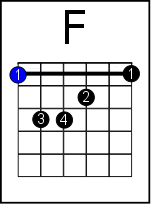
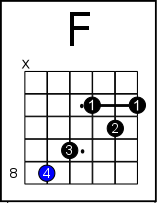
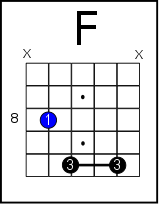

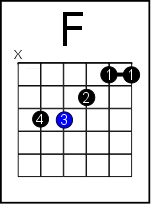



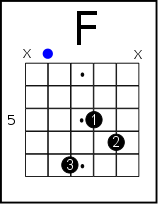
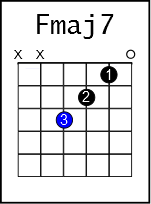
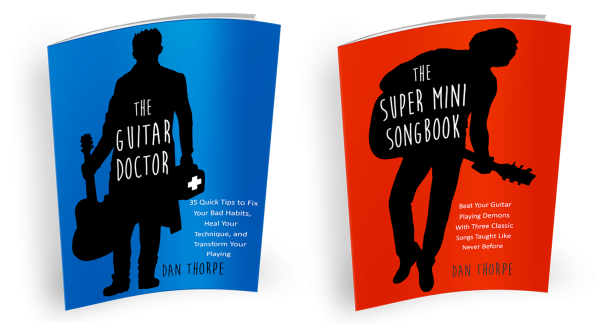
As a beginner I’ve known how to play F Through your tips
It`s my pleasure, Peter. Keep on rockin` that (now not so) dreaded F chord!
Great read! You validated many of my frustrations with humor, so thank you for the laughs as well.
Hey Doug, it`s my pleasure. Glad to know you are enjoying my often bizarre humour too!
Thanks dude….
It`s a pleasure! 🙂
I am a 70 year old beginner and this article has really helped me. Great info.!
Just a quick question: On shape Two, you mention placing the index finger “at the fifth fret.” Is this a typo, and should it read “at the second fret”?
Hi Alfred, thanks for the kind words. No, this wasn`t a typo, for this shape (number 2) it should be played higher up the fretboard so that the index finger is on fret 5.
This allows the pinkie which is playing the root note for this shape on the note of F located at the 8th fret of the A string.
This is a different way of playing F than many are used to. Let me know if you have any other questions.
How do I play the F#IA# chord?
Hi Romeo, never heard of this chord! Could you clarify which chord you mean, please? Thanks. Dan
Hi Dan, great presentation on the many way an F can be played, thanks! I have a question I think you can answer.
I learned 43 years ago to play chords like E major and minor, A minor, B minor, with ring and middle fingers the way you show in shape 4. Every other player I’ve ever seen uses shape 1. Is there a compelling reason to unlearn and learn the traditional fingering? The easy answer would be “do what works best for you”, but i figure there must be a reason for the fingering.
Thanks!
yes
‘How about for ‘Shape 1’ only barring top 2 strings with ‘finger 1’ , and curling your thumb around to complete the barre on the bottom E string.
Before I found you this chord was like: F this sh.t I’m out! XD Thanks so much!
Thank you sir, great resource for older beginners. Appreciate it.
On shape 5 is relatively easy to mute the first string with the pinkie
Also, I think that with a little effort and training, you can mute the low E string with a gentle touch of the ring finger.
I’m thinking to give I try, because It is the most comfortable and versatile shape without barre. So muting the six string could be and improvement on strumming, If the previous or next chord uses the sixth string or If you accidentally pick the sting on this shape .
But I’m not sure at all.
Guitar is not my first instrument and though I can play a couple of chords, I can’t really manage any of these F versions. I have very small hands (and feet!) and I have great difficulty just getting my fingers in the approximate right places, not to mention pressing down on the string or not accidentally touching another. On the piano my hands reach an octave, but only enough just to play it.
With the guitar I can play a full C chord though it’s not always clear. It can take a few adjustments before it sounds. The chord I play best is G Major. I can manage D major, though I have to make sure to roll my fingers toward myself.
Thankfully, I don’t have to be great, but I would like to at least be competent!
Also, not necessarily chord-related, but do you have any tips for people who are constantly having to translate the strings? I know the strings going from low to high, and if I’m not sure of a pitch, I have to go through that whole sequence first.
I’ve been playing for 50 years. The @#$%^&* F key was near the last I learned—and not all that long ago, either.
In accompaniment, I’d fake it—and I’m embarrassed to use the capo on the first fret (for some reason, I’m okay with the second and fourth—maybe cuz it looks more like I know what I’m doing).
Naturally, I had to learn how to play in the key of C, so I’d sneak in a wimpy little stripped F or maybe even an neck-choking inversion—sooner n play a barre F. In fact, the first song I learned was Johnny Horton’s then-current hit “Battle of New Orleans” in G (of course) and it took me a looooong time to master the C chord—but my little six-year-old hand eventually got it. Maybe it was so traumatic, I avoided F for decades after that!
But the KEY of F—never mind the Key of C IV-chord—forget it!!
Well, now I’m old—which is perfect for my native genre of the Blues, especially the vocals—but my singing range is getting more and more limited (cigarettes was good for timbre—not so good for emphysema…) One day I was asked to record an album before kicking the bucket and one song I really wanted to cover was “Tourna Surriento” —in neapolitino, no less. But my vocal range varying almost by the hour, the song’s range being rather a stretch, and our budget being modest, , I had to learn it in all twelve keys so’s to be prepared to do it in as few takes as possible (with a ton of rubato that’d gotten habitual for this mostly solo-player, the engineer’s insistence that the guitar and vocals be done in separate tracks made this number the hardest thing I ever did—I don’t speak Italian, let alone Neapolitian— but it still only took one take for each track—a sweaty day in early March on the East Coast of Vancouver Island!) So that’s how I learned to overcome the fear of F (and every other key).
After 50 years, a player figures chi’s learned as much as chi gonna learn. But, I tell ya, learning to play in F opened up a whole new world and, a course, worlds upon worlds—like, I never woulda bothered with the key of B-flat, much less D-sharp before this. It’s sure been great to get out of well-worn ruts. And it’s a right education to realize covering a number in the key the composer intended makes it much, much fuller (my practice number was Willie Nelson’s “Crazy”) but by the gift of serendipity, I started doing rock-a-billy numbers in F, too—it’s a great “un-shuffle” and awesome dissonance of the 6th and 7th down a the bottom of the neck (momentarily, in the genre-beat, naturally!)
It’s been a lonely two years for a lot of musicians during Covid. Tomorrow I’m a go play lead CW swing with last band I played live with—two and a half years ago. For the occasion I been sketching a CW song name a “F F” about the experience of learning this great guitar key—that’s how I come across your blog here. I enjoyed it a lot—no fuss, no muss, no fifty dollar words and arcane theory.
Thanks and keep on rockin’!
Oh yeah: the “F” in “F F” could mean ‘fret’ or ‘fear’ or ‘frustration’—as well as almost anything one could thing of…
Why are the fretting circles done in blue .? But most of the circles are in black ?
The notes in blue are the root notes. For this chord, these are the F notes and are important as these are the main bass notes in the chord. Cheers. 🙂
Thanks Dan.
Practicing guitar for 2 years and bass for 1 year. Love it.
Purchased a strumming book from you.
Your F chord write-up is the best I have ever seen on the Internet. I am going to my guitar room now now to practice all of it.
Well done.